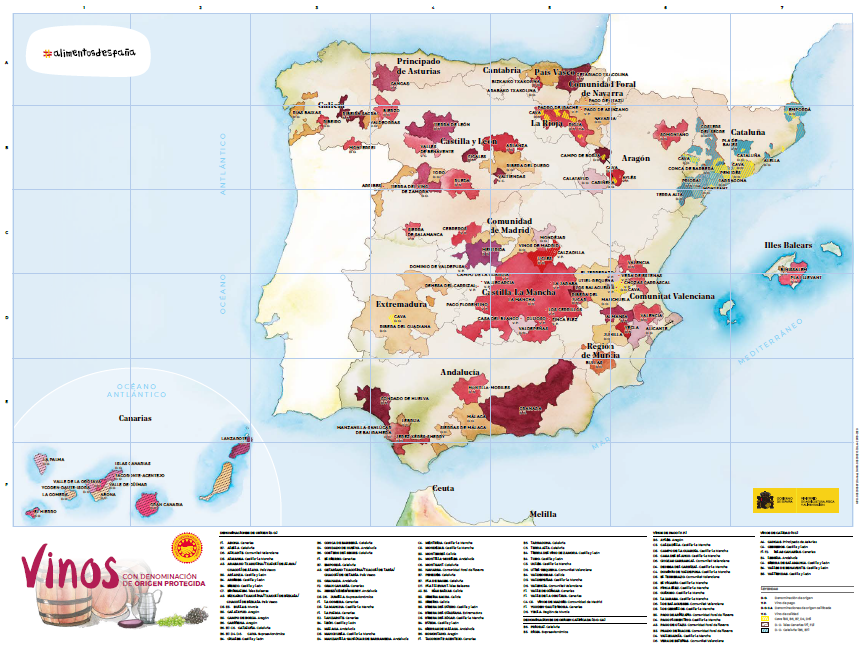All Of Spain #1
One of the first posts and tasting-series in the new LiquidThoughts wine category is a somewhat ambitious affair. Yes, you probably interpreted the title correctly, All of Spain. Why Spain of all places as the first, larger project? That will be explained separately in a somewhat more philosophical and melancholic article. Let's focus directly on our target here: Spain as a wine country. Like all wine-producing countries, Spain has different levels of categorization and territorial divisions. There are larger regions (labelled the largest on the map down below), but these say relatively little about the wines, both in terms of possible characteristics and legal requirements. At the smallest level, we theoretically have >120 legal designations for Spanish wines. However, we want to focus on the heart, the recognized DO (Denominación de Origen) and two DOCa (Denominación de Origen Calificada), which are also probably the most famous regions (Rioja and Priorat). DOCa is a special category that, in addition to the existing DO regulations, only includes regions that have historically proven their ability and stable quality throughout the region over a long period of time. Nevertheless, this still brings us to a whopping 70 stations to try out, a joyful task...
We will go into the individual characteristics of the regions from time to time in the coming articles in the Spain series, while this is intended to be more of a slow, gentle introduction. Apart from perhaps the USA, hardly any other wine country has experienced such breathtaking development in recent decades as Spain. The country with the world's largest wine growing area, which is unfortunately still regarded by many as a source of uninspiring mass-produced wines, has been making a name for itself since the 1990s. And especially in the last 10 years, thanks to a leap in quality and a broad and interesting range of wine styles, it is as big as never before. Within 30 years, Spain has emerged from its slumber to become one of the most promising, original and well-organized wine-producing countries. We will not go into the wine history or details of the entire country here, there are wonderful, much more knowledgeable places to find that information at. A recommendation for those interested in history — like myself — would be, for example, this article about the whole history of wine in Spain, back to antiquity, a fascinating read.
But now finally to the first, today's, part of a longer journey through the country. Four wines are presented in each tasting, with an attempt to cover even within each round as much of the country as possible. This is in order to really taste the differences in the terroir and the regions, which is rather more difficult with two very small DOs located right next to each other.
We represented the German-Spanish cliché par excellence in the first tasting already: Mallorca (wine: Son Puig). A fantastic island for viticulture, it has already produced some cult wines and in recent years has also seen some exciting, younger projects away from the mainstream island hype. In order to go all-in with the geographical spread and distance for this set, we are also travelling as far as possible to the other side of the country, to the west coast of Spain, north of Portugal. Here lies Rias Baixas (wine: La Carmina), known for its white wines, which often have mineral and tropical fruit flavors. The region is also home to one or two interesting indigenous grape varieties. With the Acústic from Montsant we are once again on the east coast, opposite of Mallorca, in the south of Catalonia. The region is bursting with different styles of wine; in addition to the world-famous cava, i.e., sparkling wine, there are equally exciting red and white wines and some rare grape varieties. Finally, there is Navarra with the Marqués de Montecierzo, the DO is located directly north-east of Rioja and has now also made a name for itself, especially for savory, full-bodied red wines, similar to its world-famous brother next door.
As I'm already 3 sets further into the tasting-series at the time of writing, I can say that this was definitely one of the most “coherent” and probably higher-rated sets on average. However, the Marqués de Montecierzo probably pushes the average rating back down into the midfield. The La Carmina from the Rias Baixas region was a positive surprise. I didn't expect much, partly because of the bottle's presentation, which was reminiscent of easy-to-drink summer wines. Yes, it was really drinkable, but as a whole you can undoubtedly see quality craftsmanship and an authentic tropical flavor and saltiness. An absolute insider tip from a region not often found here in Germany. The aforementioned second wine in the set was a real let-down. The nose was still quite solid, a typical Spanish Reserva with plenty of oak aging, but in the mouth it had little to offer in the way of excitement and was frighteningly thin for a Reserva in terms of volume. There are hundreds of better alternatives when it comes to Spanish Reservas, even or especially from Navarra.
2022 La Carmina Rías Baixas
-
100% Albariño grapes from local vineyards in the municipality of Arbo, located in Condado do Tea at an altitude of over 950 metres and without any barrel ageing.
Category: White wine
Country of origin: Spain
Region: Rias Baixas D.O.
Designation/Sub-Region: Condado Do Tea
Producer: Bodegas Y Vinedos Tamaral
Grape variety: Albariño (100%)
Alcohol content: 12,5 %
Residual sugar: 2,7g/l
Acidity: 5,8g/l
Price: 12-14€
Nose:
Fresh and relatively full-bodied, young, crisp pineapple, some passion fruit and light grapes, fresh lemon and some vanilla, nice lime notes
Taste:
Fresh, crisp and yet also creamy, the acidity is not too pronounced, yellow apples, passion fruit, pineapple, vanilla, citrus peel, relatively short finish, but nice balance and mineral freshness
Comment:
Nice, fresh-fruity all-rounder with suitable food, for more it lacks a little finesse and complexity in the finish, acidity pleasantly low or: sweetness-acidity balance is exactly to my taste.
88P
2016 Marqués de Montecierzo Reserva Edición Limitada
-
Aged 18 months in French oak barrels.
Category: Red wine
Country of origin: Spain
Region: Navarra D.O.
Designation/Sub-Region: -
Producer: Bodegas Marques de Montecierzo
Grape variety: Tempranillo, Garnacha, Merlot, Cabernet Sauvignon
Alcohol content: 14%
Residual sugar: -
Acidity: -
Price: 12-14€
Nose:
Blackberries, black cherry, toasted oak, leather, balsamic notes, eggplant, a little forest floor, later clear notes of mocha
Taste:
Lots of oak, mocha, licorice, blackberries mashed a long time ago and preserved with spices, balsamic notes
Finish:
Difficult, interesting notes, but despite the spiciness it is slightly watery and flat, lacks some body. Nevertheless, maybe an intriguing accompaniment to matching food.
83P
In the second half of the tasting we find two early, real highlights of the trip to Spain (again, I'm already at part 5 in real time). The Acústic is a real piece of art for the price, around €15 for a delicate yet complex dancer on the tongue. Spain in its modern form, and one of its best expressions, especially in this price category. Silky, fresh and yet with beautiful depth.
On Mallorca we have another beauty, quite powerful and flavorsome. Not really typical of Mallorca, since it stems from the mountainous region of the island and shows fewer to none of the salty notes that are often found in wines from the island. Here we have something more for friends of dry, full-bodied and spicy red wines, which definitely applies to me. Beautiful art of blending the 4 grape varieties here, also a top candidate in the price range. Especially as Mallorca's prices rise sharply as soon as word gets around about a brand or a bodega.
2019 Acústic Celler Montsant Acústic
-
Made from 60-80 year old vines in the Montsant region and barrel aged for 9-10 months.
Category: Red wine
Country of origin: Spain
Region: Montsant D.O.
Designation/Sub-Region: -
Producer: Bodegas Acústic Celler
Grape variety: 65% Carinyena, 35 % Garnatxa
Alcohol content: 14%
Residual sugar: 1,8g/l
Acidity: 5,5g/l
Price: 14-16€
Nose:
Black cherries, silky and elegant on the nose, hints of minerals, followed by some dry tobacco, blackberries, subtle wood, a hint of vanilla
Taste:
With almost no sweetness and a certain fresh acidity, very smooth and light on the tongue, but also dark notes of blackberries, licorice, tobacco, some dark chocolate, noticeable minerality, black cherries, plums
Finish:
Very, very elegant wine, despite little sweetness, the combination of an extremely silky-elegant body and dry-dark notes manages to inspire me. Noble, elegant Spaniard with an exciting combination of grape varieties, literally dances across the tongue
90P
2017 Bodegas Son Puig Vino de Finca
-
The small family winery Son Puig is tucked away in the foothills of the Tramuntana mountains. Composed of the four grape varieties Cabernet Sauvignon, Callet, Merlot and Tempranillo, the wine is matured for 10 months in oak barrels.
Category: Red wine
Country of origin: Spain
Region: Mallorca
Designation/Sub-Region: VdT Mallorca
Producer: Bodega Son Puig
Grape variety: Cabernet Sauvignon 34%, Callet 5%, Merlot 45%, Tempranillo 16%
Alcohol content: 14%
Residual sugar: -
Acidity: -
Price: 16-18€
Nose:
Fresh cassis, exciting green notes are immediately noticeable, green peppers, some bay leaf and nutmeg, slate
Taste:
Green notes in between, zucchini, laurel, juniper, cassis, blackberries, tannins relatively young but well integrated, nothing overwhelms you brutally
Finish:
It does a great job of integrating the spice and green notes into the fruit, never seems too much
89P







